This website uses cookies so that we can provide you with the best user experience possible. Cookie information is stored in your browser and performs functions such as recognizing you when you return to our website and helping our team to understand which sections of the website you find most interesting and useful.
Young Children’s Consumption of 100% Fruit Juice by Racial-Ethnic Characteristics of Their Mothers
March 28, 2023

Congress authorized the Special Supplemental Nutrition Program for Women, Infants, and Children (WIC) as a pilot program in 1972 and made WIC permanent in 1974. Administered by the Food and Nutrition Service (FNS) of the U.S. Department of Agriculture (USDA), WIC supports the nutritional needs of pregnant, post-partum, and breastfeeding women and children from birth through age 5 all of whom live in households with low incomes and are at nutritional risk. WIC offers nutritious supplemental foods, nutrition education, and referrals for healthcare services. Currently, the program is the third-largest nutrition assistance program in the U.S. In 2020, WIC served about 7 million women, infants, and children, with children between the ages of 1 and 5 years making up half of the WIC population.1
USDA FNS funded a study of the nutrition and health outcomes of children who enrolled in WIC around the time of birth — the WIC Infant and Toddler Feeding Practices Study-2 (WIC ITFPS-2). Designed and administered by Westat, WIC ITFPS-2 followed children from birth through age 6 years, regularly collecting information from mothers2 on the foods and beverages that their children consume during 24-hour periods. Though all WIC ITFPS-2 participants were enrolled in WIC around the time of the child’s birth, families did not need to continue participating with WIC to stay with the study.
Key Highlights
Based on analysis of dietary recall information from a nationally representative sample of children in families with low incomes:
- The typical preschooler who drinks 100% fruit juice overconsumes.
- The risks of children overconsuming 100% fruit juice differs significantly across racial-ethnic subpopulations.
- Children who drink 100% fruit juice are more likely than those who do not drink these beverages to meet the recommended level of total fruit intake.
Context for this analysis
Recently, Westat staff collaborated with diet-quality researchers to examine how measures of total diet quality may change with the implementation of new dietary recommendations for young children.3 The analysis suggested that the 100% fruit juice recommendations from the 2020–2025 Dietary Guidelines for Americans (DGA) may differentially impact diet-quality estimates when the data are examined by racial-ethnic groups. This issue brief elaborates on findings implicit in that article, placing the discussion of 100% fruit juice within the context of current recommendations and proposed WIC food packages.
WIC food package for children. The current WIC food package for children between the ages of 1 and 5 years includes a maximum allowance for juice, either 100% fruit or vegetable, of 128 fluid ounces (fl. oz.), which translates into just over 4 fl. oz. of 100% fruit juice per day in a typical month (Figure 1).4 In November 2022, FNS proposed revising the contents of the food packages it offers. Reducing the amount of 100% juice offered to 64 fl. oz. for children and allowing participants to substitute whole fruits and vegetables in lieu of the 64 fl. oz. of 100% juice were among the proposed revisions.5 This proposal means that the revised food package would provide for about 2 fl. oz. of 100% fruit juice per day in a typical month. Because WIC food packages seek to support optimal nutrition, it is important to understand the context for this proposal.
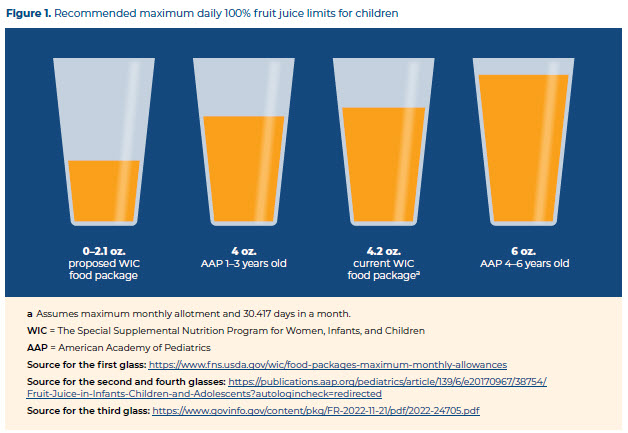
Recommendations for consumption. Since 2001, the American Academy of Pediatrics (AAP) has recommended limiting young children’s consumption of 100% fruit juice: children ages 1 through 3 years should consume no more than 4 fl. oz. of 100% fruit juice per day and children ages 4 to 6 years should consume no more than 6 fl. oz. a day.6 As justification, AAP cites detrimental effects of overconsumption ranging from increased risk of dental caries to inappropriate weight gain.7 The 2020–2025 DGA embraced limiting 100% fruit juice for children in the second year of life (i.e., between 12 and 23 months), but did not put forward specific limits for children ages 2 years and older.8 Instead, the 2020–2025 DGA recommended for all people age 2 and older that less than half of an individual’s total fruit intake come from 100% fruit juice. Both the 2020–2025 DGA and the discussion of the proposed WIC food packages recognize that 100% fruit juice does not have the same fiber benefits as whole fruit, and fiber is generally underconsumed by Americans.
Levels of 100% fruit juice intake
WIC ITFPS-2 data indicate that mean consumption of 100% fruit juice was 6.1 fl. oz. on a given day for study children at age 2 (Figure 2). At age 5,9 mean consumption was 5.9 fl. oz. on a given day. At all ages, median consumption on a given day was lower than mean, indicating that there were some children who drank a lot more 100% fruit juice than others. Quartile analysis of children’s intakes found that at ages 2 and 5, consumption was at least 8 fl. oz. for those in the top quartile and 0 fl. oz. for children in the bottom quartile. In other words, the top 25 percent of children drank at least 1 cup of juice, while the lowest 25 percent drank none.
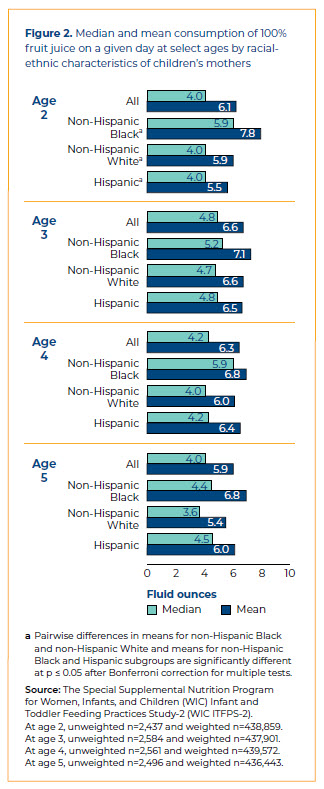
There appeared to be differences in the levels of children’s consumption when analyzed by the racial- ethnic characteristics of their mothers; however, only those differences at age 2 were statistically significant (Figure 2). At age 2, children with non-Hispanic Black mothers consumed an average of 7.8 fl. oz. on a given day, while children with non-Hispanic White mothers consumed an average of 5.9 fl. oz., and children with Hispanic mothers consumed an average of 5.5 fl. oz. At age 5, children with non-Hispanic Black mothers consumed an average of 6.8 fl. oz. on a given day, while children with non-Hispanic White mothers consumed an average of 5.4 fl. oz., and children with Hispanic mothers consumed an average of 6.0 fl. oz. Across the 4-year period, consumption was relatively stable: on average, children in this low-income population drank about 6 fl. oz. of juice on a given day at age 2 and continued to do so through age 5. Regardless of measure used (mean or median), the typical child consumed either at or above the upper limit of the AAP recommendation at ages 2 and 3. By age 4, median consumption was compliant with AAP guidance, but mean consumption for some subgroups continued to exceed the recommendation.
100% fruit juice consumption relative to the DGA recommendation
As mentioned, the DGA recommends that no more than half of total fruit consumption come from 100% fruit juice. Examination of the contribution of 100% fruit juice to total fruit consumption revealed that the contribution was close to the upper limit of the DGA recommendation (50%) regardless of maternal racial-ethnic characteristics (Figure 3). On average, the percentage contribution of 100% fruit juice for 2- and 3-year-old children with non-Hispanic Black mothers exceeded the recommended limit. At all ages, differences between non-Hispanic Black and non- Hispanic White subgroups were statistically significant.
Because some children do not consume any 100% fruit juice, including these children in the analysis can hide important subgroup differences. We found that 30 percent of the children did not consume 100% fruit juice on a given day at age 2. At this age, children with non-Hispanic White mothers were significantly more likely than children with non-Hispanic Black mothers to be nonconsumers, and children with Hispanic mothers were significantly more likely than children with non-Hispanic White mothers to be nonconsumers. At age 5, 38 percent did not consume 100% fruit juice on a given day, and children with Hispanic mothers were significantly more likely than children with non-Hispanic White mothers to be nonconsumers.
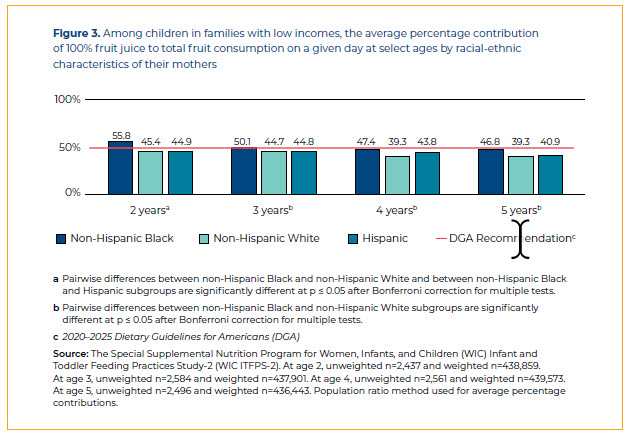
Quartile analysis of dietary intakes for children who drank 100% fruit juice indicated that children in the top quartile drank at least 12 fl. oz. on a given day at each age, 2 through 5. Children in the lowest quartile drank up to 4 fl. oz. on a given day at ages 2 and 3 and up to 4.9 fl. oz. at ages 4 and 5.
Examination of the contribution of 100% fruit juice to total fruit intake among those who drank 100% fruit juice showed that average contribution typically exceeded 50 percent of total fruit intake regardless of the mother’s racial-ethnic characteristics (Figure 4). Children with non-Hispanic Black mothers exhibited the largest average contribution at each age. However, after adjusting for multiple comparisons, the only statistically significant differences were between children with non-Hispanic Black mothers and children with Hispanic mothers at ages 2 and 5.10
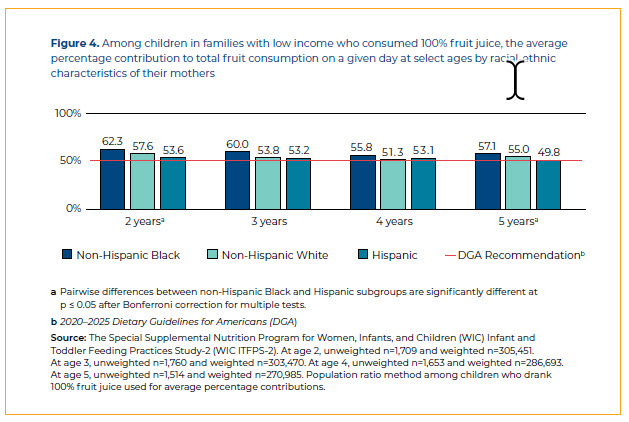
The DGA recommendation for total fruit
The 2020–2025 DGA recommendations for total fruit intake differ by a child’s age and activity level. The recommendation for a moderately active 2-year-old is 1 cup-equivalent of fruit per day. The recommendation for a moderately active 5-year-old is 1.5 cup-equivalent of fruit per day. Assuming that calories consumed were commensurate with activity levels, the percentages of children meeting the DGA recommendation for total fruit intake differed notably by whether the child consumed 100% fruit juice on a given day. Children who drank 100% fruit juice were more likely to meet that day’s fruit intake recommendation than children who did not consume these beverages (Figure 5). Thus, 100% fruit juice consumption helped many children achieve the recommended level of intake based on one day of intake.
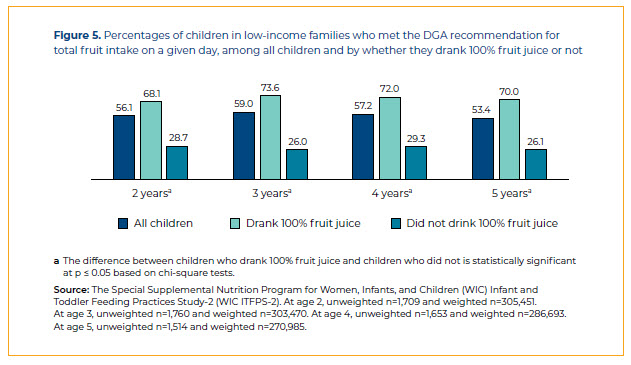
Summary
Our analyses of 100% fruit juice consumption by a nationally representative cohort of young children in families with low incomes found that the typical child who drank 100% fruit juice overconsumed on a given day. Generally, when racial-ethnic differences were significant, children with non-Hispanic Black mothers were at greater risk of overconsumption than children with mothers from other racial-ethnic subgroups.
USDA FNS has the practical task of supporting young children’s nutritional needs in the context of multiple nutrition assistance programs that offer foods and beverages for preschool-aged children. Given consumption patterns evident in the WIC ITFPS-2 data, consumption of 100% fruit juice helps many children achieve recommended levels of fruit intake, but risks of overconsuming juice may be unequal across racial- ethnic subpopulations within the WIC community. These considerations suggest that the proposed revisions to the 100% fruit juice component in the WIC food packages may seek to balance the health benefits and overconsumption risks of consuming these beverages.
Acknowledgments
The author would like to thank all of those who contributed to the analyses and offered comments on this Issue Brief. Brenda Sun programmed the analyses in SAS. Amanda Reat, Shannon Whaley, Lorrene Ritchie, Thea Zimmerman, Elizabeth Gearan, Allison Hyra, and Timothy Mulcahy provided helpful comments throughout the process.
About the author
Christine Borger, PhD, a senior economist at Westat, is the Principal Investigator on the WIC Infant and Toddler Feeding Practices Study-2 (WIC ITFPS-2). She plans and implements all analyses for this landmark study funded by the U.S. Department of Agriculture, Food and Nutrition Service. In addition to a deep understanding of the WIC program, her areas of expertise include statistical modeling, which she regularly uses to assess relationships between dietary intakes and health outcomes. Dr. Borger is a co-author of a recent article in The Journal of Nutrition that examines different measures of diet quality of toddlers and possible implications for understanding which populations are at risk of future diet-related diseases.
Endnotes
- Kline, N., Zvavitch, P., Wroblewska K., Worden, M., Mwombela, B., and Thorn, B. (2022). WIC participant and program characteristics 2020. Washington, DC: U.S. Department of Agriculture, Food and Nutrition Service. Available at: https://fns-prod.azureedge.us/sites/default/files/ resource-files/WICPC2020-1.pdf.
- Nearly all adult study participants were biological mothers of the children; however, the children’s primary caregivers — regardless of gender or filial relationship — were respondents.
- Kay, M., Duffy, E., Sun, B., and Borger, C. (2023). Comparing diet quality indices for low-income 24-month-old toddlers: Exploring changes driven by 2020–2025 Dietary Guidelines for Americans (DGA). The Journal of Nutrition, 153(6). Available at https://www. sciencedirect.com/science/article/pii/S0022316622131342.
- Food and Nutrition Service (USDA). (n.d.). WIC food packages — regulatory requirements for WIC-eligible foods. Available at: https://www.fns.usda.gov/wic/wic-food-packages- regulatory-requirements-wic-eligible-foods#JUICE%20(Women%20 and%20Children).
- Food and Nutrition Service (USDA). (n.d.). WIC: Revisions in the WIC food packages. Available at: WIC: Revisions in the WIC Food Packages | Food and Nutrition Service (usda.gov).
- Abrams, S.A. (2017). Weighing in on fruit juice: AAP now says no juice before age 1. AAP News. Available at: https://publications.aap. org/aapnews/news/14804.
- Heyman, M.B., Abrams, S.A., Heitlinger, L.A., Cabana, M.D., Gilger, M.A., Gugig, R., Hill, I.D., Lightdale, J.R., Daniels, S.R., Corkins, M.R., de Ferranti, S.D., Golden, N.H., Magge, S.N., and Schwarzenberg, S.J. (2017). Fruit juice in infants, children, and adolescents: Current recommendations. Pediatrics, 139(6). Available at: https:// publications.aap.org/pediatrics/article/139/6/e20170967/38754/ Fruit-Juice-in-Infants-Children-and-Adolescents.
- U.S. Department of Agriculture. (2020). Dietary guidelines for Americans. Washington, DC: Author. Available at: https://www. dietaryguidelines.gov/sites/default/files/2020-12/Dietary_Guidelines_ for_Americans_2020-2025.pdf.
- At age 5, children are no longer age-eligible for WIC benefits. The data on 5-year-olds were collected from 14 days prior to the child’s fifth birthday to 28 days after. It is possible that some children interviewed at this time were receiving WIC food packages and some were not.
- We used Bonferroni correction to adjust for multiple comparisons.
Focus Areas
Food and Nutrition Maternal Health Social ServicesCapabilities
Disproportionately Affected Populations EquityFeatured Expert

Christine Borger
Principal Research Associate
-
Perspective
Teacher Apprenticeships Strengthen the WorkforceJuly 2024
Many state education agencies (SEAs) are addressing teacher shortages by creating and expanding alternative paths to the teaching profession. One fast-growing option is teacher apprenticeships,…
-
Expert Interview
Passport to Careers: Aiding Foster and Homeless Young AdultsJuly 2024
The Passport to Careers program in Washington State supports former foster youth and homeless youth unaccompanied by a parent or guardian in achieving their college…
-
Perspective
Highlights of Westat at AAPOR 2024May 2024
We’ve returned from the 79th Annual American Association for Public Opinion Research (AAPOR) Conference, held May 15-17 in Atlanta, where we caught up with colleagues…
